Please report any broken links or trouble you might come across to the Webmaster.
Please take a moment to let us know so that we can correct any problems and make your visit as enjoyable and as informative as possible.
| Click On Image For Full Size | Size | Image Description | Source By |
|
|---|---|---|---|---|
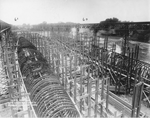 |
1.50k | AA-2 (SS-60) & AA-3 (SS-61), aft looking forward, Fore River Ship Yard, 16 July 1917. | US National Archives photo # 16lc 5 from NARA, College Park, Maryland, courtesy of Sean Hert. Editors Note: None of the photos from NARA would have seen the light of day here if it were not for the effort of Sean Hert to scan and send them to me. He and Tracy White have done this innumerable times and I owe them a heart felt debt of perpetual thanks for being my legs from over 6,000 miles away. | |
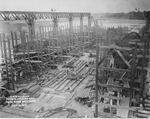 |
1.20k | AA-2 (SS-60) & AA-3 (SS-61), forward looking aft, Fore River Ship Yard, 16 July 1917. | US National Archives photo # 16lc 7 from NARA, College Park, Maryland, courtesy of Sean Hert. | |
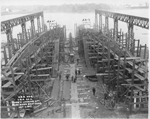 |
956k | AA-3 (SS-61) & AA-2 (SS-60), forward looking aft, Fore River Ship Yard, 4 October 1917. | US National Archives photo # 16lc 4 from NARA, College Park, Maryland, courtesy of Sean Hert. | |
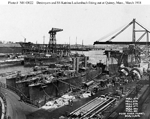 |
106k | Ships fitting out at the Fore River shipyard, 19 March 1918. The six destroyers are Little (DD-79), Kimberly (DD-80), Sigourney (DD-81), Gregory (DD-82), Colhoun (DD-85) and Stevens (DD-86), which had builder's hull numbers 274-277 and 280-281 respectively. The freighter at right is Katrina Luckenbach, yard hull # 267, which served as Katrina Luckenbach in 1918-19. Most of the equipment on the pier is for her. Note the large submarine being built in the background, under the revolving crane. It is probably S-1 (SS-105) or one of the AA-1 class: The AA-1 (SS-52), T-2 (SS-60) or T-3 (SS-61). |
USNHC photograph # NH 43022. | |
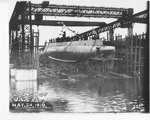 |
869k | T-3 (SS-61) still on her scaffolding just prior to her launch at the Bethlehem Shipbuilding Co.,Fore River Plant, Quincy, MA., 24 May 1919. | US National Archives photo from NARA, College Park, Maryland, courtesy of Sean Hert. | |
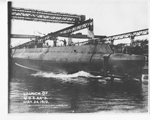 |
754k | Sponsor: Mrs. John N. Jordan (Lilian Terhune), wife of Commander J. N. Jordan, P. C, U. S. Navy, on duty at the works. The T-3 (SS-61) heads (or tails) for the water during her launching on 24 May 1919. | Text info via Ships of the United States Navy and their sponsors 1797-1913 (Hall) (1913) v2., pg 234. US National Archives photo from NARA, College Park, Maryland, courtesy of Sean Hert. | |
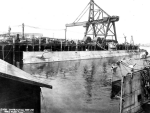 |
164k | The T-3 (SS-61) at the Fore River Plant of Bethlehem Shipbuilding, Quincy, Mass. There is an unidentified S-boat tied to one of the other two T-boats. It might be supposed that the other T-boat is the T-2 since the T-3 and T-2 were at Fore River at the same time in 1919. | USN photo courtesy of usssubvetsofwwii.org. Text courtesy of Ric Hedman. | |
 |
144k | Circa post 1920 photo of the K-2 (SS-33), T-1 (SS-52) & T-3 (SS-61). In the foreground is another unidentified K-boat. The T-1 has a canvas covering over her deck gun. Note differences in the construction of the T-1 & T-3 conning tower fairwaters. | USN photo & text courtesy of Ric Hedman. | |
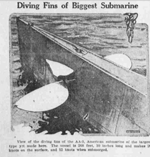 |
494k | Diving Fins of Biggest Submarine View of the diving fins of the AA-3 (SS-61), American submarine of the largest type yet made here. The vessel is 208 feet, 10 inches long and makes 20 knots on the surface, and 12 knots when submerged. | Image and text provided by University of Nebraska-Lincoln Libraries, Lincoln, NE. Photo from The North Platte Semi-Weekly Tribune. (North Platte, Neb.) 1895-1922, 20 August 1920, Image 6, via chroniclingamerica.loc.gov. | |
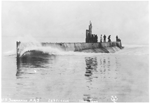 |
987k | T-3 (SS-61) on sea trials, circa December 1920. | Photo provided by Robert Hurst. | |
 |
483k | Our New Battleships & T-Boats Lead World's Navies Vessels of the North Carolina Class When Completed Will Put United States in Advance of Any Nation When Major Fighting Craft Are Considered---Fleet Submarines Under Construction Completely Overshadow Famous Deutschland in Size and Speed Besides Possessing Latest Marvels in Mechanical Equipment. | Image and text provided by Connecticut State Library, Hartford, CT. Photo from The Bridgeport Times and Evening Farmer. (Bridgeport, Conn.) 1918-1924, 31 May 1921, Image 12, via chroniclingamerica.loc.gov. | |
 |
286k | AA-3 (SS-61) at Norfolk Navy Yard, VA. circa 1921. | Collection of Lawrence Archambeault during his naval service, 1919-1922. Source: US Naval History Heritage and Command, Photo No. S-526-A via Mike Green. | |
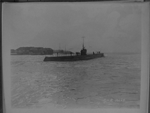 |
547k | T-3 (SS-61) makes for the sea. | US National Archives photo C & R # 10224, from NARA, College Park, Maryland, courtesy of Sean Hert. | |
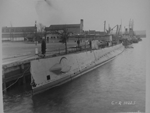 |
556k | T-3 (SS-61) sprouts a small nursery on her deck. | Photo i.d. courtesy of Ric Hedman. US National Archives photo C & R # 10225, from NARA, College Park, Maryland, courtesy of Sean Hert. | |
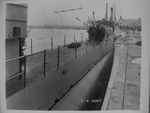 |
576k | Getting the boat ready for Xmas or Arbor Day in this amidship view. | US National Archives photo C & R # 10227, from NARA, College Park, Maryland, courtesy of Sean Hert. | |
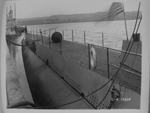 |
581k | Old Glory flies from the jack staff. | US National Archives photo C & R # 10228, from NARA, College Park, Maryland, courtesy of Sean Hert. | |
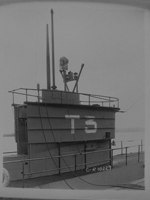 |
492k | Conning tower & bell of the T-3 (SS-61). | US National Archives photo C & R # 10229, from NARA, College Park, Maryland, courtesy of Sean Hert. | |
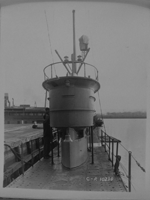 |
522k | The bell is inscribed AA-3, 1920. | US National Archives photo C & R # 10230, from NARA, College Park, Maryland, courtesy of Sean Hert. | |
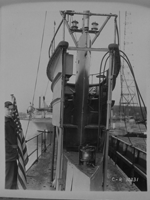 |
573k | The wheel of the AA-3 in the conning tower. | US National Archives photo C & R # 10231, from NARA, College Park, Maryland, courtesy of Sean Hert. | |
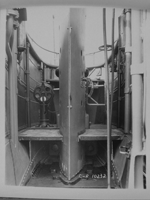 |
576k | Rivet construction is evident in abundance in the building of the AA-3's conning tower. | US National Archives photo C & R # 10232, from NARA, College Park, Maryland, courtesy of Sean Hert. | |
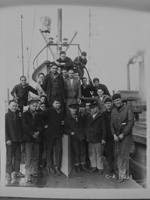 |
542k | AA-3's crew pose for a group shot around the conning tower. | US National Archives photo C & R # 10233, from NARA, College Park, Maryland, courtesy of Sean Hert. | |
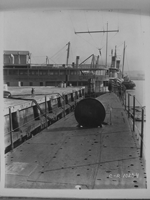 |
681k | A dog on the dock and a bush on AA-3's stern, salvation ever so close. | US National Archives photo C & R # 10234, from NARA, College Park, Maryland, courtesy of Sean Hert. | |
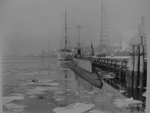 |
558k | Stern view of the T-3 (SS-61) amidst a flow of ice. | US National Archives photo C & R # 10226, from NARA, College Park, Maryland, courtesy of Sean Hert. | |
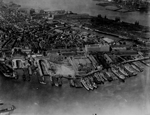 |
2.17k | Massachusetts - Boston Navy Yard, 1921. Among the many ships seen below: Across from the Constitution (left center) are 2 submarines, possibly the AA-2 (SS-60) & AA-3 (SS-61). Chuck Haberlein writes: No idea about the subs (although they appear to be about 250' long). The 2 Virginia class battleships are Virginia (BB-13) & the New Jersey (BB-16). Alongside the two BBs is one of the "scouts" Chester (CL-1), Birmingham (CL-2) or Salem (CL-3). Appearance of the stacks makes me think it's Chester, which was overhauled at Boston Navy Yard in 1919-20 and laid up there from June '21 until 1927. She looks like she's laid up in this photo. There are also two of the Denver class (CL-16 & 17) small cruisers (rated as gunboats in '20 & '21 and light cruisers after that) toward the right. During the '20s, several of those were actively employed keeping the Central Americans in line. |
Photo i.d. & text courtesy of Chuck Haberlein Jr. National Archives Identifier: 23941503 Local Identifier:Local Identifier:18-AA-72-51 Photo courtesy of catalog.archives.gov via Robert Morgan. | |
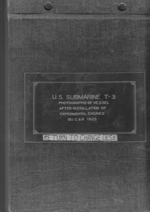 |
869k | Cover of the following photo collection taken after installation of the experimental engines aboard the T-3 (SS-61). At the time of the T-boats' decommissioning, the idea of testing German-produced diesel engines in one of them had been bantered about in Navy circles. T-1 (SS-52) had originally been designated for this purpose, but funds were not then available. In 1925, when money was forthcoming, it was T-3 that came out of mothballs for the tests. On 1 October 1925, T-3 was recommissioned at Philadelphia. For the following 21 months, she tested her newly installed 3,000-horsepower M.A.N. diesel engines for the Bureau of Engineering. |
Text courtesy of DANFS. US National Archives photo from NARA, College Park, Maryland, courtesy of Sean Hert. | |
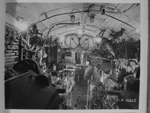 |
731k | Engine room, forward end of engines, looking forward. Both air compressors are visible on each side. Double door to control room is at the forward end and one of the periscopes is visible through the doors. There is an interesting side bar to the T-boats. As the first of the Navy's "Fleet" submarines, they were intended for high sustained surface speed (20 knots). With diesel engine technology still in its infancy in the U.S. when these boats were designed, there were no engines powerful enough to provide the required speed with the standard diesel-direct arrangement (one engine on each shaft). So the designers came up with the idea of putting two engines in tandem on each shaft, with front engine connected to the aft engine at the crankshaft. This was one of those "it sounded like a great idea at the time" solutions that turned out to be a complete failure. The problem came from the impossibility of precisely synchronizing the speeds of the two engines. If one of the engines was even slightly out of time with the other massive vibrations would occur, eventually tearing both engines apart. This would be challenging even with today's computerized control systems, but with the manual systems of the day it was a foregone conclusion. The engines were reliability nightmares and the boats could reach designed speeds only under optimum conditions and then only for short periods. Simon Lake's G-2 (SS-27) was the only other U.S. submarine to use tandem engines, and Lake was equally unsuccessful with the concept. In addition, the design of the tankage forward left these boats with a smaller than anticipated amount of reserve buoyancy and when coupled with the design of the bow it caused the bow to burrow into the water, practically submerging the boat at higher speeds. A rebuild of the tankage failed to rectify the problem. The T-class boats were a classic case of ambition outweighing the available technology. In 1920 we just didn't have the technology to build a true fleet boat. We would have to wait another 15 years for the gadgets and widgets to catch up to the dreams of the designers and the ambition of the admirals. |
Text courtesy of David Johnston US National Archives photo C & R 10235 from NARA, College Park, Maryland, courtesy of Sean Hert. | |
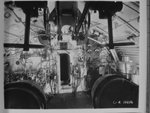 |
673k | Engine room, aft end of engines, looking aft. Double doors lead to motor room/AMR. Notice the two engine order telegraphs on the right side. These were used to send speed orders to the engine room from the control room. | Text i.d. courtesy of David Johnston & Ric Hedman. US National Archives photo C & R 10236 from NARA, College Park, Maryland, courtesy of Sean Hert. | |
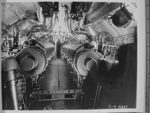 |
826k | Engine room, aft end looking forward. Both of the big M.A.N. replacement diesels are visible. | Text i.d. courtesy of David Johnston & Ric Hedman. US National Archives photo C & R 10237 from NARA, College Park, Maryland, courtesy of Sean Hert. | |
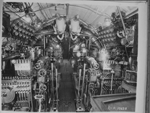 |
877k | Engine room, forward end looking aft. The large levers are clutches for the air compressors on each side and air start valve actuators for the engines. | Text i.d. courtesy of David Johnston & Ric Hedman. US National Archives photo C & R 10238 from NARA, College Park, Maryland, courtesy of Sean Hert. | |
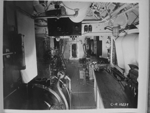 |
652k | Motor room/AMR, aft end looking forward. Double door to the engine room is at the forward end. | Text i.d. courtesy of David Johnston & Ric Hedman. US National Archives photo C & R 10239 from NARA, College Park, Maryland, courtesy of Sean Hert. | |
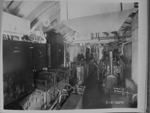 |
623k | Motor room/Auxiliary machinery room (AMR), middle of compartment looking aft. Visible at the far end is the watertight door to a topside access trunk. | Text i.d. courtesy of David Johnston & Ric Hedman. US National Archives photo C & R 10240 from NARA, College Park, Maryland, courtesy of Sean Hert. | |
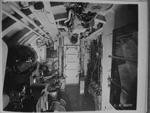 |
676k | Motor room/AMR, aft end of compartment, looking aft. This picture is the same compartment as photo 10240, only taken from a vantage point further aft. | Text i.d. courtesy of David Johnston & Ric Hedman. US National Archives photo C & R 10241 from NARA, College Park, Maryland, courtesy of Sean Hert. | |
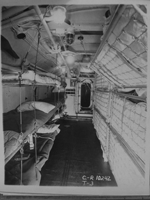 |
643k | Battery compartment upper level. Forward enlisted berthing, port side looking forward. The T-boats had double bulkheads between each main compartment. The space between the bulkheads in this photo served as an access trunk to a hatch leading topside. In this view both watertight doors in the trunk are open and officer's berthing can be seen beyond. | Text i.d. courtesy of David Johnston & Ric Hedman. US National Archives photo C & R 10242 from NARA, College Park, Maryland, courtesy of Sean Hert. | |
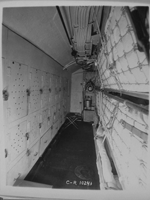 |
601k | Battery compartment upper level. Forward enlisted berthing, Starboard side looking aft. Lockers on the left, folded bunks on the right. Battery ventilation blowers on the aft bulkhead. | Text i.d. courtesy of David Johnston & Ric Hedman. US National Archives photo C & R 10243 from NARA, College Park, Maryland, courtesy of Sean Hert. | |
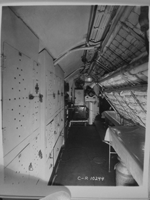 |
575k | Battery compartment upper level. Aft enlisted berthing, starboard side looking aft. Lockers on the left, bunks on the right. Note the messing tables underneath the folded bunks. This space doubled as enlisted messing. Battery ventilation blowers on the aft bulkhead. The double watertight door led to the galley. The boat's gyroscope is in the left corner. | Text i.d. courtesy of David Johnston & Ric Hedman. US National Archives photo C & R 10244 from NARA, College Park, Maryland, courtesy of Sean Hert. | |
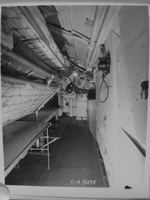 |
588k | Battery compartment upper level. Aft enlisted berthing, port side looking aft. This is the opposite side of the compartment show in photo 10244. | Text i.d. courtesy of David Johnston & Ric Hedman. US National Archives photo C & R 10245 from NARA, College Park, Maryland, courtesy of Sean Hert. | |
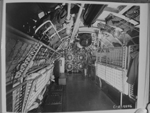 |
738k | Torpedo room, aft end looking forward. This photo was taken right next to the ladder shown in photo 10247. | Text i.d. courtesy of David Johnston & Ric Hedman. US National Archives photo C & R 10246 from NARA, College Park, Maryland, courtesy of Sean Hert. | |
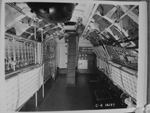 |
751k | Torpedo room, middle of compartment, looking aft. This room doubled as enlisted berthing and folded bunks are visible. In the center is an access ladder leading to hatch going topside. | Text i.d. courtesy of David Johnston & Ric Hedman. US National Archives photo C & R 10247 from NARA, College Park, Maryland, courtesy of Sean Hert. | |
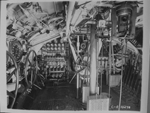 |
822k | Control room, middle of room, port side looking forward. On the left are the wheels for the bow and stern planes. Visible between the wheels is the depth gauge. On the forward bulkhead is what appears to be a combination air and trim manifold. To the right is the helm wheel. Notice the handle extensions, necessary to develop the required amount of force on the wheel to turn it when operating the helm manually. On the far right are the operating levers for the ballast tank Kingston valves. When opened they allowed water to flood into main ballast tanks. Visible in the center are two of the boat's periscopes, along with some portable electric space heaters (the perforated metal boxes on the deck). | Text i.d. courtesy of David Johnston & Ric Hedman. US National Archives photo C & R 10248 from NARA, College Park, Maryland, courtesy of Sean Hert. | |
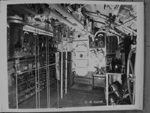 |
764k | Control room, middle of room, port side looking aft. On the left is the ships electrical switching panel. Two periscopes are visible in the center, and the watertight door to the engine room in the center. Visible on the right is the stern plane control wheel. | Text i.d. courtesy of David Johnston & Ric Hedman. US National Archives photo C & R 10249 from NARA, College Park, Maryland, courtesy of Sean Hert. | |
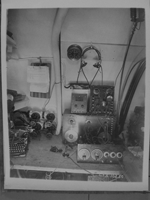 |
584k | Ship's radio. Located in the torpedo room, starboard side forward. | Text i.d. courtesy of David Johnston & Ric Hedman. US National Archives photo C & R 10250 from NARA, College Park, Maryland, courtesy of Sean Hert. | |
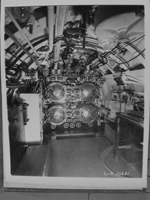 |
715k | Torpedo room, middle of room looking forward. Ship's radio on the right. | Text i.d. courtesy of David Johnston & Ric Hedman. US National Archives photo C & R 10251 from NARA, College Park, Maryland, courtesy of Sean Hert. | |
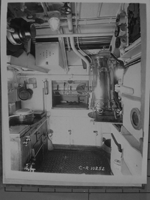 |
623k | Galley looking to port. Photo taken from the scullery. The galley was located in its own compartment between the control room and the battery compartment/enlisted berthing. | Text i.d. courtesy of David Johnston & Ric Hedman. & Ric Hedman. US National Archives photo C & R 10252 from NARA, College Park, Maryland, courtesy of Sean Hert. | |
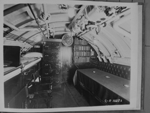 |
603k | Torpedo room aft end. Officer's berthing, middle of compartment looking forward. Non-watertight door leads to the torpedo room. | Text i.d. courtesy of David Johnston & Ric Hedman. US National Archives photo C & R 10253 from NARA, College Park, Maryland, courtesy of Sean Hert. | |
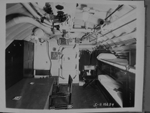 |
586k | Torpedo room aft end. Officer's berthing, middle of compartment looking aft. Door to battery compartment/enlisted berthing in the center. On the left is a door leading to the officer's toilet (called a head). | Text i.d. courtesy of David Johnston & Ric Hedman. US National Archives photo C & R 10254 from NARA, College Park, Maryland, courtesy of Sean Hert. | |
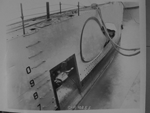 |
523k | Starboard diving plane. | US National Archives photo C & R 10255 from NARA, College Park, Maryland, courtesy of Sean Hert. | |
 0806146 |
1.86k | T-3 (SS-61) at Norfolk Navy Yard, VA. circa 1921. | Photo courtesy of history.navy.mil | |
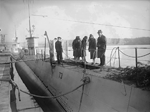 |
220k | Assistant Secretary of the Navy Theodore D. Robinson and his family inspect the submarine T-3 (SS-61) on 23 December 1925. | Photo # npcc 27370, LC-F81-38812 courtesy of the Library of Congress via Bill Gonyo. | |
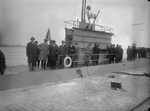 |
208k | Wilbur and House Naval Affairs inspect sub T-3 (SS-61) at Navy Yard, 30 December 1925. | Photo # npcc 27391v, LC-F81-38874 courtesy of the Library of Congress via Bill Gonyo. | |
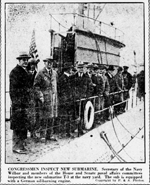 0806144 |
NR | CONGRESSMEN INSPECT NEW SUBMARINE. Secretary of the Navy Wilbur and members of the House and Senate naval affairs committees inspecting the new submarine T-3 (SS-61) at the navy yard. The sub is equipped with a German oil-burning engine. | Copyright by P. & A. Photos. Image and text provided by Library of Congress, Washington, DC. Photo from Evening Star. [volume] (Washington, D.C.) 1854-1972, 31 December 1925, Image 16, via chroniclingamerica.loc.gov. | |
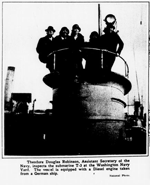 0806145 |
NR | Theodore Douglas Robinson, Assistant Secretary of the Navy, inspects the submarine T-3 (SS-61) at the Washington Navy Yard. The vessel is equipped with a Diesel engine taken from a German ship. | Image and text provided by Library of Congress, Washington, DC. Photo from Evening Star. [volume] (Washington, D.C.) 1854-1972, 03 January 1926, Image 90, via chroniclingamerica.loc.gov. | |
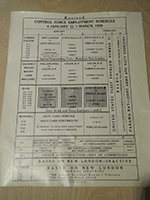 |
1.72k | Control Force Employment Schedule, 4 January to 1 March 1926. US Fleet Problem Number VI. | Photo courtesy of Steve Ireland. | |
| Back To The Main Photo Index | Back To the Submarine Index |
|
Problems and site related matters, E-mail Webmaster |
|
This page is created by Gary Priolo and maintained by Michael Mohl All Pages © 1996 - 2025 NavSource History |